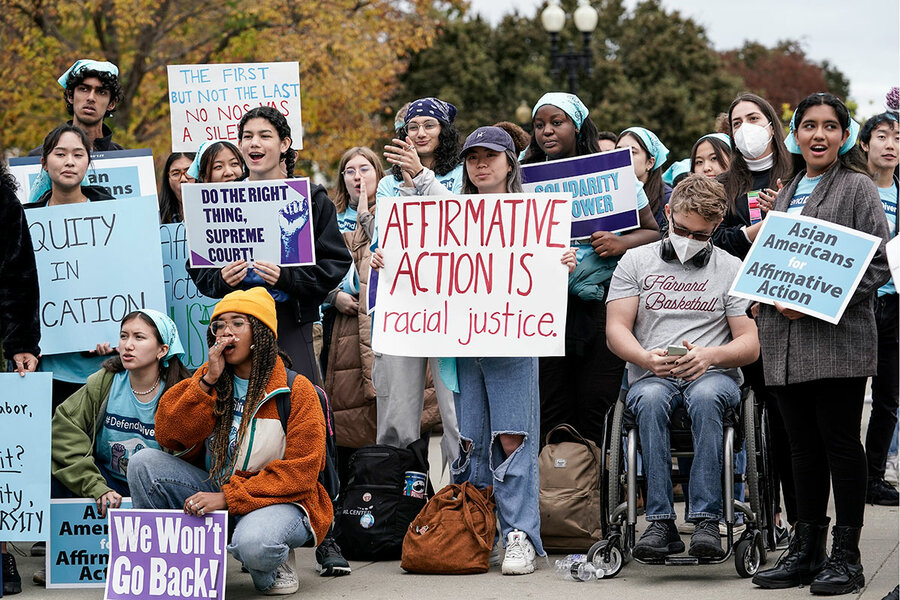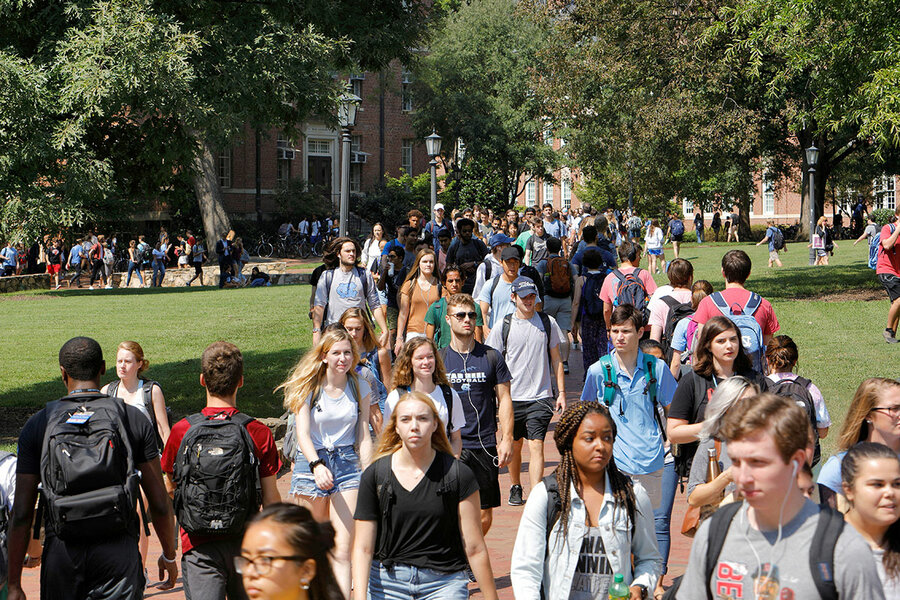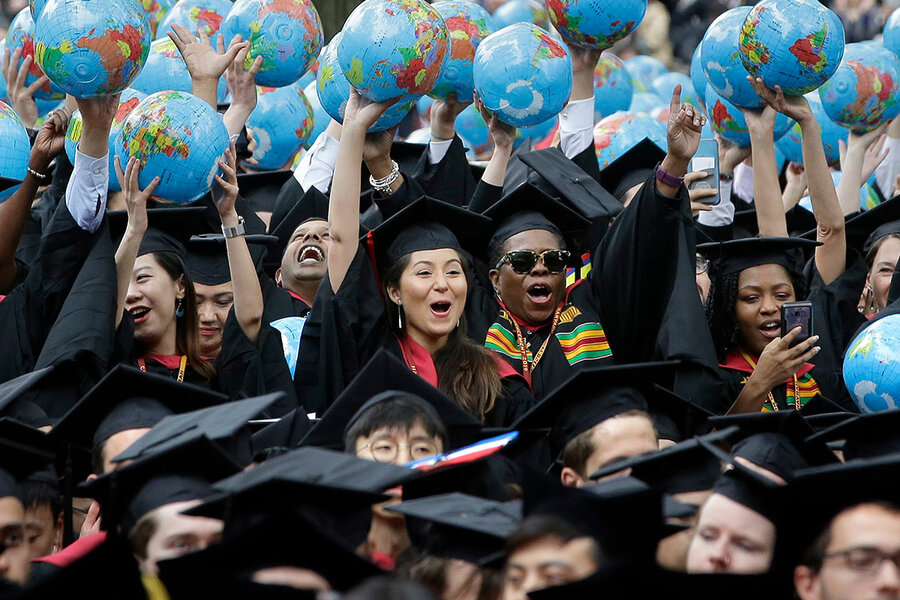
Just after lunch on a Thursday afternoon in late April, a chilly breeze and overcast sky have mostly blocked the sun from smiling on the campus of the University of California, Santa Barbara. The assistant director for diversity initiatives, Marcus Mathis, and a student helper from one of the school’s fraternities pile used paper plates, plastic utensils, and waste into huge trash bags.
Almost 200 mostly Black students from six high schools in Southern California’s Woodland Hills, some 80 miles southeast, have just left UCSB’s Loma Pelona Center. They spent the day listening to speakers, watching performances, and munching on catered grilled tri-tip, barbecue chicken, baked beans, potato salad, salad, freshly made garlic bread, and rice and peppers.
They didn’t come just for the food. They came to see faces that look like them – faces on heads with braids and Afros, with noticeable tattoos and familiar athletic wear – explain how they enrolled, navigated the mostly white affluent space that is UCSB, and found a family away from home to create memories that will travel through life.
Why We Wrote This
A story focused on
What comes after affirmative action for college? Universities in states like California and Michigan, where race-based admissions had already been banned, may hold answers.
“I’m glad this went well today. I spent a lot of nights worrying about how this would turn out,” Mr. Mathis says, mopping sweat from his brow as he looks up at Fluke Fluker, a recently retired high school teacher. Mr. Fluker is a founder of The Village Nation, a 20-year-old community-based organization that the school partnered with to get the students to campus.
“UC Santa Barbara has been a jewel for us,” says Mr. Fluker.
He started Village Nation, he explains, to get Black children in particular to make better choices, which would affect their grades, attendance, and disciplinary record. A byproduct has been college enrollment for many, and the partnership with UCSB has given students an opportunity to redefine themselves, create clean slates, and leave behind things that they have outgrown.
“Something that was really attractive to us is that it’s located in such a space that’s far enough for our kids to get away and get their independence and create their autonomy, but close enough that they can still stay connected to home,” says Mr. Fluker.
“UC Santa Barbara has a history of producing scholars, inventors, and scientists,” he adds. “Schools [like that] partnering with grassroots organizations that work directly with the kids is critical, and it completes the cycle in a positive way.”
Now, after the U.S. Supreme Court ruled Thursday that two race-based college admissions policies are unconstitutional, UCSB may become a reference point for universities around the country. While the high court appears to have left universities with some wiggle room to consider race in admissions, those policies are now, for the first time in 45 years, broadly prohibited nationwide.
California, though, has not had affirmative action for 25 years, and universities there have found a way forward. For Mr. Mathis and Mr. Fluker, the way forward on this April afternoon is to a nearby beach, where students pick seashells, pose for pictures, and play icebreaker games with members of UCSB’s Black Student Union.
This is the work. Sometimes it’s arduous, with long days and nights in rental cars traveling up and down America’s most populous state to speak with prospective students. Sometimes it’s asking for favors from faculty and staff or student groups when potential students visit campus. Sometimes it’s heavy labor – like breaking down tables. But the work is always strategic; it’s always intentional.
“We don’t try to do this as a sales job,” says Mr. Mathis. “Doing admissions for Black students is a lot different than maybe doing it in general. Everybody else is going to come here and love it. Generally people across the country know about our campus and what we have to offer academically. But Black students, all they know about Santa Barbara is that there’s no Black people.”
Retooling out of necessity
When California voters banned affirmative action with Proposition 209, which became effective for students entering public colleges and universities in the fall of 1998, schools like UCSB had to pivot and be more tactical and strategic in recruiting. Schools and colleges in eight other states, including Michigan and Washington, also had to adapt after their states banned race-based admissions.
“The immediate effect was that the number of admitted minority students went down precipitously” in those states, says Jennifer Mason McAward, a professor at the University of Notre Dame Law School.
“They were able to, over 15 years and lots of very expensive efforts, get the numbers roughly back to where they were. But even then, the numbers of African American and Native American students never fully rebounded.”
When Proposition 209 passed in California, the immediate result was a steep enrollment decline for underserved minorities and first-generation college students of color for schools in the selective UC system. The decline was 50% at the University of California, Los Angeles. Many places still struggle decades later. Today, UCLA has a 5% Black population, and at Berkeley it’s 3.4%. Both used to be higher.
The University of California submitted an amicus brief in the two affirmative action cases, stating that selective schools might not be able to achieve student body diversity with race-neutral measures. “To fulfill their role of preparing successive generations of citizens to succeed in an increasingly diverse nation, universities must retain the ability to engage in the limited consideration of race contemplated by the court’s precedents,” it wrote.
Systems like UC exponentially increased recruitment and partnerships in high schools that enroll predominantly students of color, says Angel Peréz, chief executive officer of the National Association for College Admission Counseling. They know ZIP codes where students apply. They build partnerships with community-based organizations and recruit in Black churches and Latino community centers.
“A lot of colleges already do this, but I’m hearing that they want to expand this because it’s going to guarantee them a pipeline,” Dr. Peréz says.
That is what Lisa Przekop knows. Ms. Przekop, director of admissions at UCSB, says the losses of schools like UCLA and Berkeley have been UCSB’s gain. The school got about 125,000 applications last year for 7,000 slots. When affirmative action was banned in California, UCSB was an aspirational Hispanic-serving institution and directed efforts to recruiting more Latino students to campus. Today, the school, which includes 23,000 undergraduates and 3,000 graduates, is 25% Chicano/Latino.
Currently, though, it has 4% Black students and only 1% Native American students. It has increased the budget and is trying new ideas to create a pipeline. Ms. Przekop can look outside her office window and see student groups giving prospective students tours. With fastidious care, her office corrals everyone – from faculty and administrators to student groups and alumni – to recruit. It has had Pulitzer Prize-winning Professor Jeffrey C. Stewart speak and has given out copies of his book “The New Negro.” It highlighted Professor Gerardo Aldana, an expert in Mesoamerican civilizations, and his work on the Marvel blockbuster “Wakanda Forever.”
“We’ve made it a point to embed ourselves all over campus, so that I have a list of faculty I can call, I have a list of students I can call, when I need help,” Ms. Przekop says.
Many of her staff members, including herself, have been advisers to student organizations. Also, with Black and Latino students in mind, Ms. Przekop’s team filmed candid videos of current underrepresented students on campus to get a picture of how life was at school. Some students admit it was difficult being the only Black person in a class. It felt isolated and lonely, and professors might have said something that offended sensitivities, Ms. Przekop says. Her office also tries to compile helpful tips, like the nearest barbers and salons that specialize in Black hair.
UCSB staffers get implicit bias training every year, especially readers, who look over applications. None of them can see application names, race, or ethnicity. UCSB keeps tight relationships with feeder schools that have sent them many students over the years, but it’s trying to add to that list, Ms. Przekop says.
“You can’t control who applies and you certainly may not be able to control the racial identity of the applicants, but you can control where you go and recruit, how you recruit,” says Dr. Peréz. “This is where the University of California, the state of Washington, and places like Michigan who have already had to deal with this for years will teach us a lot.”
A “colorblind” Constitution?
Affirmative action in higher education has faced constitutional challenges for 45 years, but the Supreme Court previously repeatedly dismissed arguments that admissions policies favoring minority applicants violate the Constitution’s guarantee of equal protection. Because a university’s interest in maintaining a diverse student body is a compelling and precisely tailored one, the court had ruled as recently as 2017, such policies are constitutional.
With its decisions Thursday striking down race-based admissions programs at Harvard University and the University of North Carolina, the current Supreme Court went the opposite direction. The rulings, both 6-3 along ideological lines, held that the programs violate the equal protection clause of the 14th Amendment.
“Many universities have for too long wrongly concluded that the touchstone of an individual’s identity is not challenges bested, skills built, or lessons learned, but the color of their skin. This Nation’s constitutional history does not tolerate that choice,” wrote Chief Justice John Roberts in the majority opinion.
Specifically, the Harvard and UNC programs “lack sufficiently focused and measurable objectives warranting the use of race, unavoidably employ race in a negative manner, involve racial stereotyping, and lack meaningful end points,” he added.
Affirmative action programs were originally intended not to increase diversity, scholars note, but to help historically disadvantaged groups, particularly African Americans, achieve full equality. It was the Supreme Court, in a 1978 decision, that made a diverse student body the “compelling interest” behind affirmative action.
And in its June 29 opinion, “the court is very, very skeptical about educational diversity and its benefits in higher education,” says Professor Mason McAward.
“It talks about it as being commendable and worthy, but really not a coherent justification. It describes it as inescapably imponderable and doesn’t defer to universities at all in terms of how they don’t want to structure their classes,” she adds.
Ultimately, as other members of the court reinforced in separate opinions, in the context of college admissions any kind of program that uses race alone to distinguish students is unconstitutional.
“Two discriminatory wrongs cannot make a right,” wrote Justice Clarence Thomas in a concurring opinion. The Constitution is “colorblind,” he added, and it prohibits “all forms of discrimination based on race – including so-called affirmative action.”
In impassioned dissents, the high court’s liberal wing accused the majority of effectively turning the Constitution inside out, using its racial equality amendments to further entrench racial inequality. The consequences, they added, could be severe.
“Today, this Court … rolls back decades of precedent and momentous progress,” wrote Justice Sonia Sotomayor. “In so holding, the Court cements a superficial rule of colorblindness as a constitutional principle in an endemically segregated society.”
In a separate dissent, Justice Ketanji Brown Jackson – who recused herself from the Harvard case – lambasted the majority for “with let-them-eat-cake obliviousness … announc[ing] ‘colorblindness for all’ by legal fiat.”
“But deeming race irrelevant in law does not make it so in life,” she added. “Having so detached itself from this country’s actual past and present experiences, the Court has now been lured into interfering with the crucial work that UNC and other institutions of higher learning are doing to solve America’s real-world problems.”
A new model?
Court watchers noted that the decision doesn’t seem to eliminate race from college admissions entirely. Universities can still consider an applicant’s “discussion” of how race has affected their life, Chief Justice Roberts noted in his opinion, so long as the discussion “is concretely tied to a quality of character or unique ability” that the applicant can bring to the university.
And hours after the chief justice read his opinion from the Supreme Court bench, President Joe Biden outlined how universities could do that.
“I propose consideration [of] a new standard, where colleges take into account the adversity a student has overcome when selecting among qualified applicants,” he said.
Colleges “should not abandon … their commitment to ensure student bodies of diverse backgrounds and experience,” he added. “We need a higher education system that works for everyone, from Appalachia to Atlanta and far beyond.”
For UCSB, new standards have been steadily built up over decades.
One of the school’s most fruitful initiatives has been LA to SB. It partners with 15 to 20 predominantly Black schools from Los Angeles to bring students to campus for a day. UCSB spends $3,000 per trip, which includes transportation, food, and swag. Students get the full-court press on campus: They meet with admissions counselors, hear application tips, and learn how to make essays stand out. They also receive campus tours, insight from current student groups, faculty presentations, and lunch. The university increased the budget for LA to SB after Black students complained to the administration that they wanted to see more people who looked like them on campus.
Technology has also helped UCSB cover more ground. Instead of visiting the same list of schools, it opts for virtual presentations so it can use money to chart new territory. Some work is service-based: Admissions officers do presentations at new schools simply to get students interested in college, even if they don’t choose UCSB.
When high school students visit, the school hosts workshops and talks with students about the personal insight questions featured on college applications. UCSB follows up with partnering schools to help edit PIQs, ask questions of students, and help them home in on what’s needed.
“We don’t do it for them, but we ask them clarifying questions. We point out things that they need to clear up for their applications to have the best chance for admission. We don’t see ethnicity, so all we can do is make sure that these Black students have the strongest application possible,” says Mr. Mathis from UCSB.
“All of those little things can help,” he adds.
Jude Kiruuta came to UCSB in 2017 because, while other schools like UC Santa Cruz accepted him, he felt like Santa Barbara wanted him.
“There was a man who worked in admissions who reached out to me through email. We just had conversations. That was important, and then we met when I came for a tour,” says Mr. Kiruuta, a senior math major.
“That made me feel like, ‘OK, they’re reaching out to me.’ None of these other schools reached out or said hello.”
Feeling wanted helped Mr. Kiruuta break out of his introverted shell. So much so that he met a plethora of friends, started a podcast on campus, and became president of the Black Student Union during his junior year. In late April, he tried to impart wisdom gained during his time at UCSB to students from The Village Nation.
Mars Baker, a high school senior from Woodland Hills, sat with friends and listened attentively. She’s already enrolled in a local community college near home, but she plans to transfer to a university later. One of the few Black students at her high school, she’s been purposely researching the Black student populations of universities.
Hence her visit to UCSB.
“I loved being able to see the different programs, the culture and what it’s like, especially as a Black person,” she says.
“I’ve heard a lot of great things about this school,” she adds. “I had a couple of family members who told me that they liked their experience here and how much it helped them grow as a person, and I think that kind of inspired me.”





